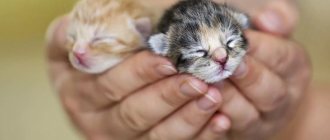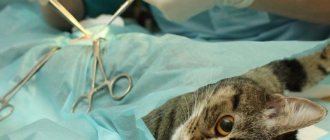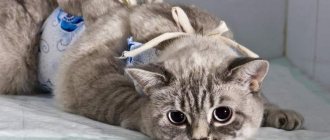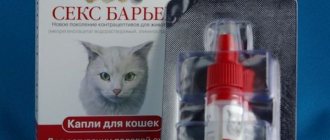Chemical sterilization of cats is a method of sterilization in which, instead of surgical intervention, special drugs are used that suppress sexual desire in cats and for some time allow changes in behavior and pregnancy.
With modern medicines this becomes possible, this is, in fact, an alternative to surgically sterilizing a cat, only unlike surgically sterilizing a cat, the effect will be temporary and will need to be constantly extended.
Features of sterilization through injection
Chemical sterilization involves the administration of a drug that contains a progesterone analogue. The hormone is responsible for the proper functioning of the genitourinary system and the condition of the mammary glands. Due to changes in its level, the cat has a desire to mate. The administration of the drug stabilizes hormonal levels for up to 6-12 months. This prevents the occurrence of estrus.
To sterilize a cat, an injection is given shortly before estrus, then the procedure is repeated after 3 months for additional stabilization. Before administering the drug, it is necessary to conduct an examination to identify potential contraindications. In 0.5% of cases, estrus persists even after using a hormonal drug. If specific symptoms appear, you should contact your veterinarian again.
How it works
Synthetic analogues of specific steroid hormones do not affect the ovaries themselves. Progestins work at a “higher level” by controlling the activity of the pituitary gland, a gland located in the brain.
The pituitary gland stops producing luteinizing hormone, which is why follicles in the ovaries do not mature and estrogen does not release. No estrogens - no estrus.
Pros and cons of chemical sterilization
Chemical sterilization of cats has a number of advantages and disadvantages.
The advantages include the following factors:
- Interruption of heat. Hormonal sterilization helps to get rid of the desire to mate. The cat’s sensations during this period can be compared to the discomfort of cystitis. Eliminating pain and itching normalizes the psycho-emotional state and helps you return to your previous lifestyle. The pet stops meowing. The risk of unwanted pregnancy and infection as a result of sexual intercourse is minimized.
- Preservation of reproductive functions. Hormonal injections are suitable for those owners who plan to resume breeding work later. However, in some cases, if complications develop, reproductive organs have to be removed, so there is a risk.
- Long duration of action of drugs. Depending on the chosen medication and individual characteristics, the period of abstinence can be 6-12 months. If there is an increased risk of pregnancy, injections are given every 5 months. Hormonal injections last longer than drops or mild sedatives.
- Efficiency. Chemical sterilization helps to achieve the desired result in 99.5% of cases. Insensitivity to drugs or an atypical reaction to active substances occurs in 0.5% of cats. However, complete removal of reproductive organs does not always lead to the elimination of unwanted behavior. If there is no reaction to the standard drug, analogues containing other active substances can be used. The procedure can be repeated only after the end of estrus.
- No surgical intervention. Chemical sterilization can be used as an alternative if there are contraindications to surgery. Hormonal drugs are used for severe heart pathologies, poor blood clotting, old age, etc.
- Changing your cat's temperament. During heat, the animal becomes irritable due to severe discomfort. The desire to mate negatively affects the pet’s lifestyle. Sleep becomes light, its duration decreases, and the cat experiences stress. During estrus, animals' appetite worsens and weight loss occurs. The pet becomes more willful and independent, less likely to pay attention to the owner. The animal may show aggression. After sterilization, pets become docile and calm due to a change in motivation.
- Fast action of drugs. The active substances enter the bloodstream immediately. Your cat may experience symptoms of heat for some time due to hormonal changes. After a few days, the side effects disappear. Hormonal levels are stabilizing. The likelihood of estrus is reduced to a minimum.
- Lack of rehabilitation period. Caring for a cat after sterilization involves monitoring it. The reproductive organs are preserved, the body is not exposed to anesthesia, and there are no stitches. The feeding regimen and diet remain the same. The injections do not affect intellectual abilities, nerve endings, etc.
Sometimes hormonal drugs are used to abruptly interrupt estrus and further carry out surgery as prescribed by a veterinarian. This can happen with diseases of the reproductive organs and the need for urgent intervention. However, in most cases, veterinarians prefer to operate on a cat during estrus without prior interruption, since the volume of lost blood increases slightly, and hormonal drugs increase the risk of developing other pathologies.
Among the disadvantages, the following factors are noted:
- High chance of complications. Tumors, mastopathy, polycystic ovary syndrome and pyometra occur most often. With mastopathy, a cat's mammary glands become enlarged. The disease can affect several structures. There is discharge from the nipples, soreness and fever. Pyometra is accompanied by purulent inflammation of the uterus and can quickly lead to death. With polycystic disease, due to the occurrence of formations, the duration of estrus and their regularity change. Overgrown cysts can impede the functioning of other organs and cause discomfort.
- Temporary effect. To further interrupt estrus, injections must be given regularly. Each procedure is associated with risk, so repeated administration of hormonal drugs is undesirable.
- Increase in body weight. Due to decreased activity and improved appetite, the animal eats more and quickly gains weight. Needs change as the pet spends less energy searching for partners, so portion sizes need to be adjusted.
The risk of third-party pathologies depends on the individual characteristics of the animal. In some cases, neoplasms or purulent inflammations appear after the first injection, so before carrying out the procedure, it is necessary to evaluate its feasibility. Complications can occur even several years after a single use of hormonal drugs. After using them, it is recommended to visit the clinic regularly (every 6-12 months) to assess the pet’s health condition and timely treatment.
Chemical sterilization is most often used in the case of animals that are of breeding value. The advisability of using hormonal drugs is due to the need to temporarily prevent pregnancy. This can happen when you move, a new animal appears in the house, a temporary change in conditions, etc.
It is not recommended to give hormonal injections to pets. With prolonged use of injections and frequent empty heats, the risk of complications increases, so it is recommended to prefer a more radical method of sterilizing cats. It is advisable to remove the ovaries along with the uterus to avoid the development of pathologies.
Indian experiment
Clinically healthy 30 cats from all over the country, weighing 2-3 kg, aged from nine months to a year, with normal libido during the breeding season (spring), were acclimatized for a month. Each cat was additionally tested by preliminary mating with a cat during the period of estrus. After this, an experiment was carried out.
The minimum effective dose of calcium chloride was estimated by randomly dividing these 30 animals into 5 groups. Each animal in the first three groups (Groups I, II and III) received a single bilateral injection of 0.25 ml of 5%, 10% or 20% sterile calcium chloride dissolved in saline.
General anesthesia (i.e., general anesthesia) was not used. It was soon found that the ideal dose was 0.25 ml of calcium chloride at a 10% concentration. The fourth group was the control group - the animals were injected with 0.25 ml of physiological solution with 1% lignocaine hydrochloride. The fifth group underwent conventional surgical castration.
The essence of the technique
Each injection was performed using sterile 1 ml syringes. The needle was directed from the apex of the testicle to its process (epidydymis). The calcium chloride solution was injected evenly throughout the entire movement of the injection needle.
The fact is that when it gets into the subcutaneous tissue and muscle tissue it causes severe necrosis, accompanied by the formation of abscesses.
None of the animals in the experimental groups suffered from fever or any significant difficulties other than a slight increase in testicular hardness upon palpation.
Experiment results
Most animals showed signs of mild discomfort about five minutes after the calcium chloride injection, but cats in the control group, which were treated with normal saline, had exactly the same reaction.
This is probably just a side effect characteristic of “foreign” fluids getting inside the testes. Mild swelling was noticed one day after the procedure. Indian veterinarians report that on average it disappeared after 72 hours, but in one case this period extended to four weeks.
A single injection of calcium chloride resulted in a significant decrease in somatic index compared to animals injected with saline alone. It also turned out that the 10% drug gives results similar to the 20% composition. The least effective was the 5% solution. The testes of animals subjected to its administration decreased in volume (approximately three times). It was found that when using 20% calcium chloride, the most significant reduction in testicular size occurs.
Precautionary measures
It has been proven that chemical sterilization can cause the development of pathologies. It is advisable to abandon this method if the cat is not of breeding value. Repeated procedures almost always cause the development of diseases of the uterus, ovaries and mammary glands. Pathologies of third-party organs appear less frequently. Their occurrence is associated with hormonal fluctuations. Progesterone regulates the functioning of many internal systems. When additional doses are administered, the independent synthesis of hormones is inhibited.
Chemical castration of a cat should not be carried out in the presence of diseases such as pyometra, neoplasms of the testes and ovarian cysts. The introduction of hormonal drugs can cause a deterioration in the pet’s condition. Before using the products, it is necessary to eliminate the underlying pathology and residual effects. Additionally, it is not recommended to give injections during estrus. This increases the risk of hormonal imbalance.
If there is an increased risk of unwanted pregnancy (free range, keeping several animals of different sexes in the same area, etc.), injections are given every 5-6 months, regardless of the presence or absence of signs of estrus. They do not wait for the next cycle to occur, as fertilization may occur.
The first injection should be given at the clinic. Later, you can administer the hormonal drug yourself after consultation, but it is recommended to undergo a routine examination before each injection. On the first day after sterilization, the cat may behave in the same way as during estrus. This is due to a sharp change in hormonal levels. After a few days the condition stabilizes. If estrus is prolonged or other side effects occur, you should contact your veterinarian.
Preparing for surgery
The operation is performed under general anesthesia, so you must first examine the cat and take tests to assess possible risks. Particular attention should be paid to older animals, as well as cats with a history of chronic diseases.
The operation creates an additional burden on the pet, therefore, to strengthen the immune system, it is first recommended to:
- deworming;
- disinfestation;
- immunization.
On the day of surgery, the animal should not be fed for 6 hours. You should give up water 3 hours before.
Preparations for chemical sterilization
For medical sterilization of cats, the most commonly used hormonal agents are Covinan and Depo-Provera. The first drug contains prolygestone, an analogue of progesterone. The product increases the viscosity of the mucous membrane and impairs the functioning of the mammary glands. Due to changes in the composition of the secretion, it becomes more difficult for sperm to implant, so pregnancy does not occur. Depo-Provera is a drug that can be used to prevent conception in both animals and humans. The active substance is medroxyprogesterone.
All information posted on the site is provided in accordance with the User Agreement and is not a direct instruction to action. We strongly recommend that before using any product, you must obtain a face-to-face consultation at an accredited veterinary clinic.
Undesirable consequences
So, you turned to a qualified veterinarian, properly prepared and cared for your pet. The operation is over and the patient feels well.
What should you pay attention to to avoid unpleasant consequences?
There is an opinion that a common complication of castration is urolithiasis (UCD).
This is not entirely true: there is no direct relationship between castration and ICD. This disease is a consequence of impaired metabolism and often occurs in animals with excess body weight.
Therefore, proper nutrition is the key to an animal’s health, and this applies not only to ICD. Diseases of the cardiovascular system, digestive tract, and joints are common consequences of obesity.
Excess body weight occurs in both castrated and non-castrated animals and depends mainly on nutrition and a genetic predisposition to obesity. The fact is that with the elimination of the reproductive instinct, the cat begins to lead a more measured life: anxiety, aggression, and the associated decrease in appetite disappear during the hunting period. Therefore, if the animal is prone to obesity, weight gain will occur faster after castration.
This is why it is important to approach feeding responsibly. For castrated animals, there are special dietary foods that are sold in veterinary pharmacies, and regarding the use of which, you can consult the seller
A veterinarian will provide more detailed advice on feeding and maintenance.
Rules
The chemical sterilization procedure involves soaking instruments in a chemical solution prepared according to instructions, with the required proportions. This stage is always preceded by disinfection, pre-sterilization cleaning and drying.
Disinfection and pre-sterilization cleaning of manicure instruments: how to choose a disinfectant and prepare the solution correctly
When immersing, the instruments must be completely dry so that the water present on them does not lead to dilution and a change in the concentration of the working solution.
Chemical sterilization of instruments requires the same sequence of preliminary processes as in the case of heat treatment in an autoclave or dry-heat oven.
To perform the procedure, you will need a working solution, one container with a lid, as for disinfection, and two containers for washing. Also tweezers, gloves, napkins. For further storage of manicure tools you will need to choose from:
- UV sterilizer;
- Sterile cabinet;
- Sterile box or box with a lid.
The algorithm of actions is as follows:
- Pour the prepared working solution of the required concentration into a container with a lid;
- The other two contain distilled or drinking purified water;
- All procedures are performed using sterile gloves;
- After drying, pre-disinfected and cleaned instruments are placed in a solution for chemical treatment for the required exposure time. Cover with a lid;
- After the time has elapsed, use tweezers and wear sterile gloves to remove and place the instruments in distilled water and rinse;
- Transfer to a third container with distilled or drinking water, rinse to remove any remaining solution;
- We take out the instruments, wipe them off with a sterile napkin, and place them on a second napkin;
- After wiping and drying all the instruments, we transfer them to a cabinet, UV sterilizer or sterile box with a lid for storage.
All manipulations are performed with sterile forceps and disinfected gloves. Instruments are immersed in the solution in an open or disassembled form. There should be at least 1 cm of the drug above them after immersion. If there are complex connections or locking parts, you can close and open them after entering the liquid.
A sterile cabinet or storage box should be lined with a sterile sheet. In the UV sterilizer, we place everything on shelves to ensure even access of light.
You can store the tool in a specialized cabinet or box for three days, then you need to take everything out again and process it again, even if the materials were not used.











